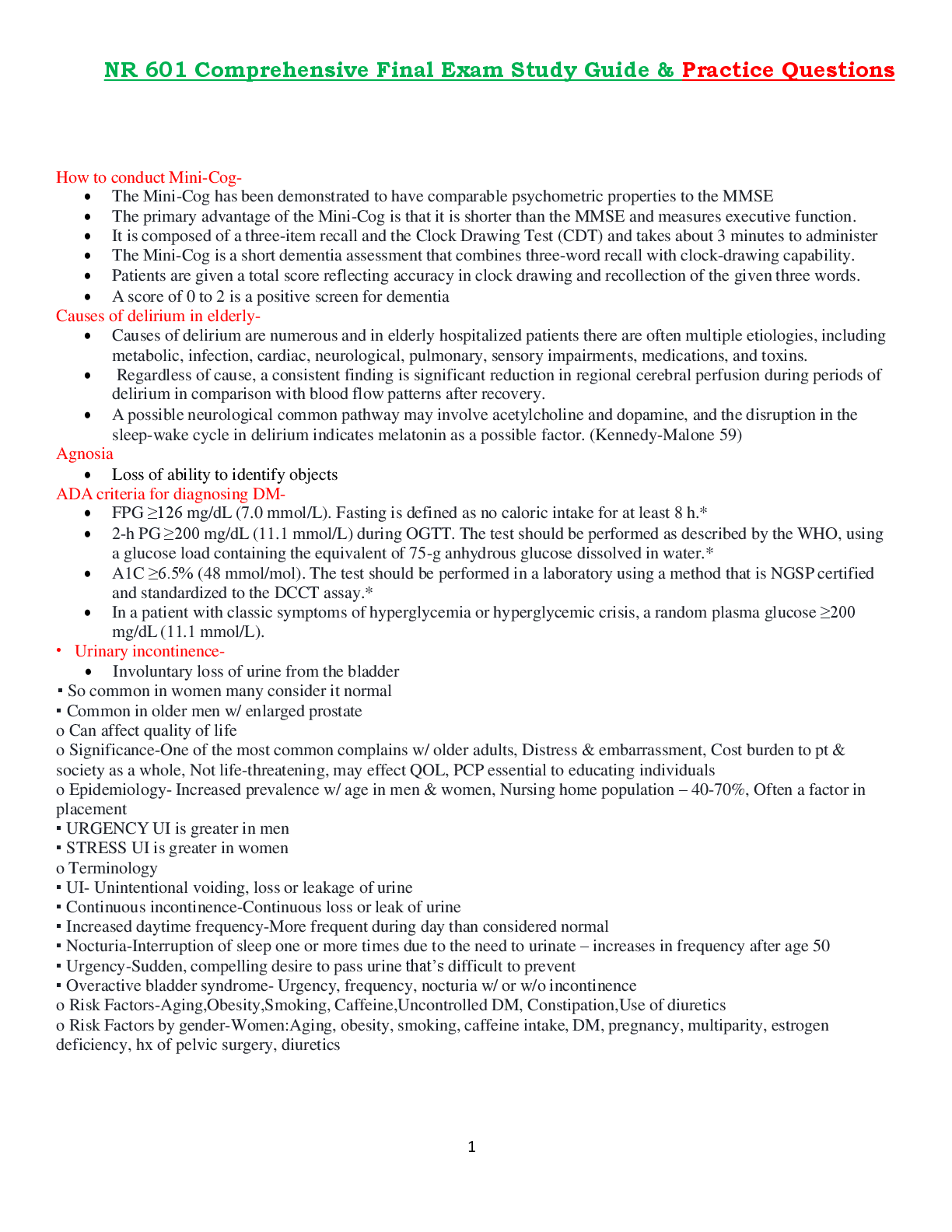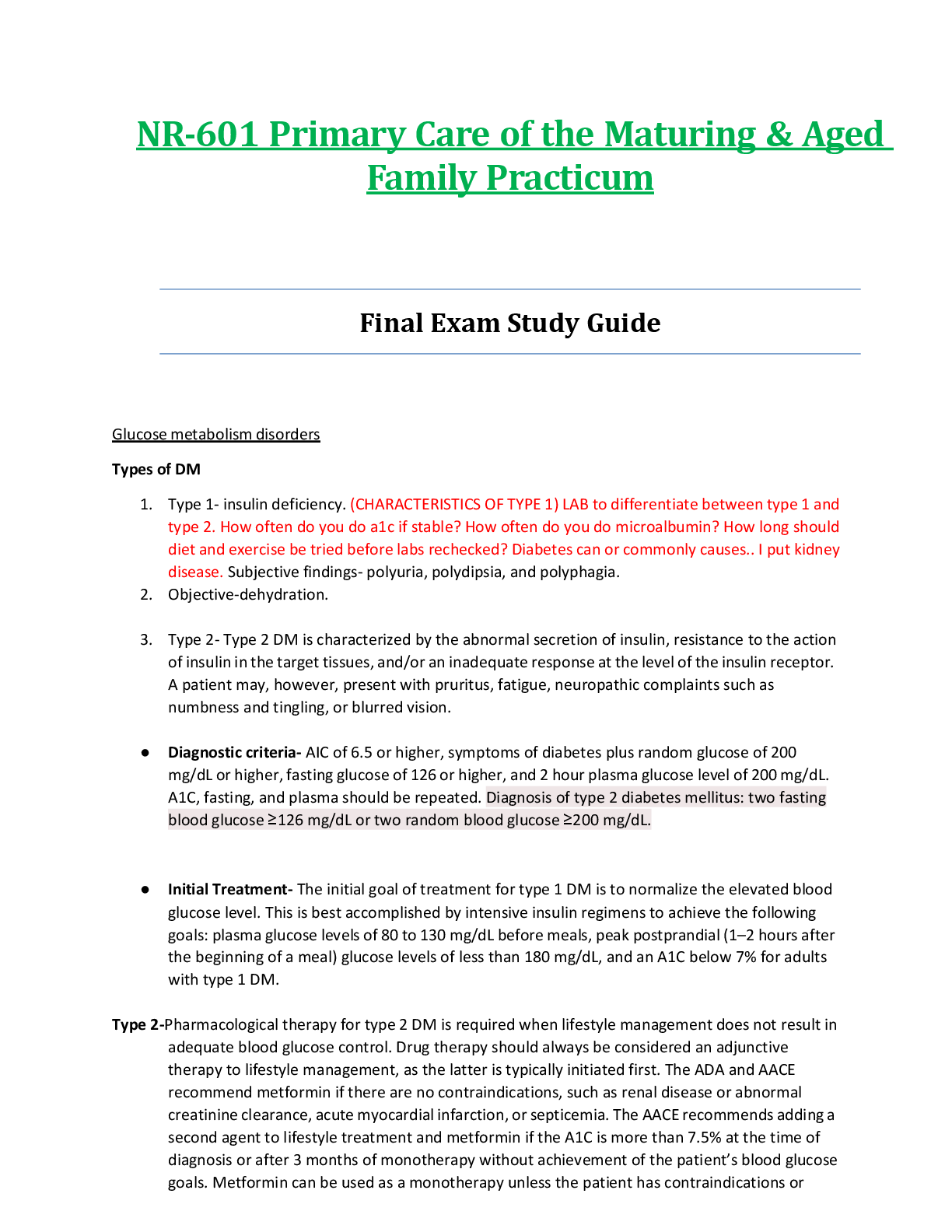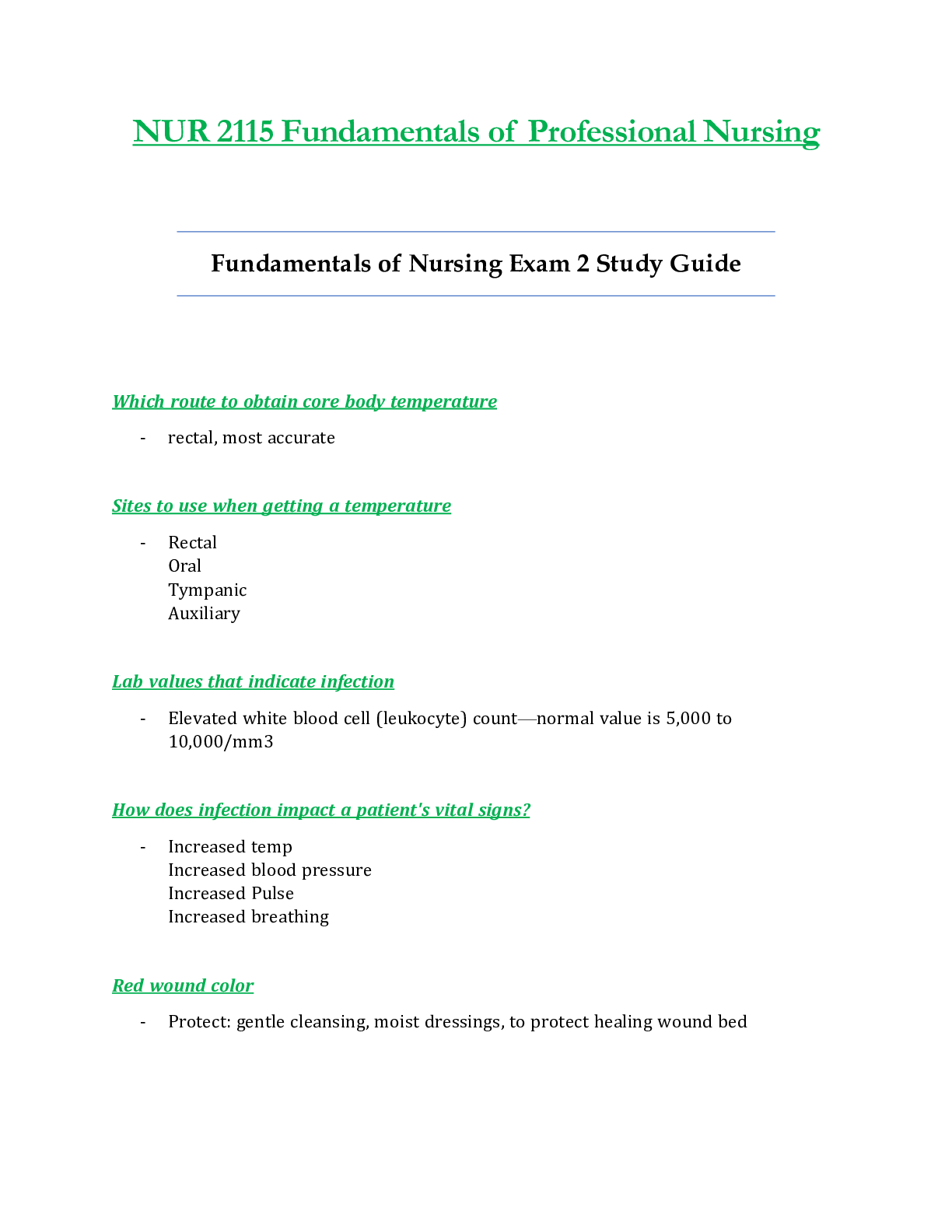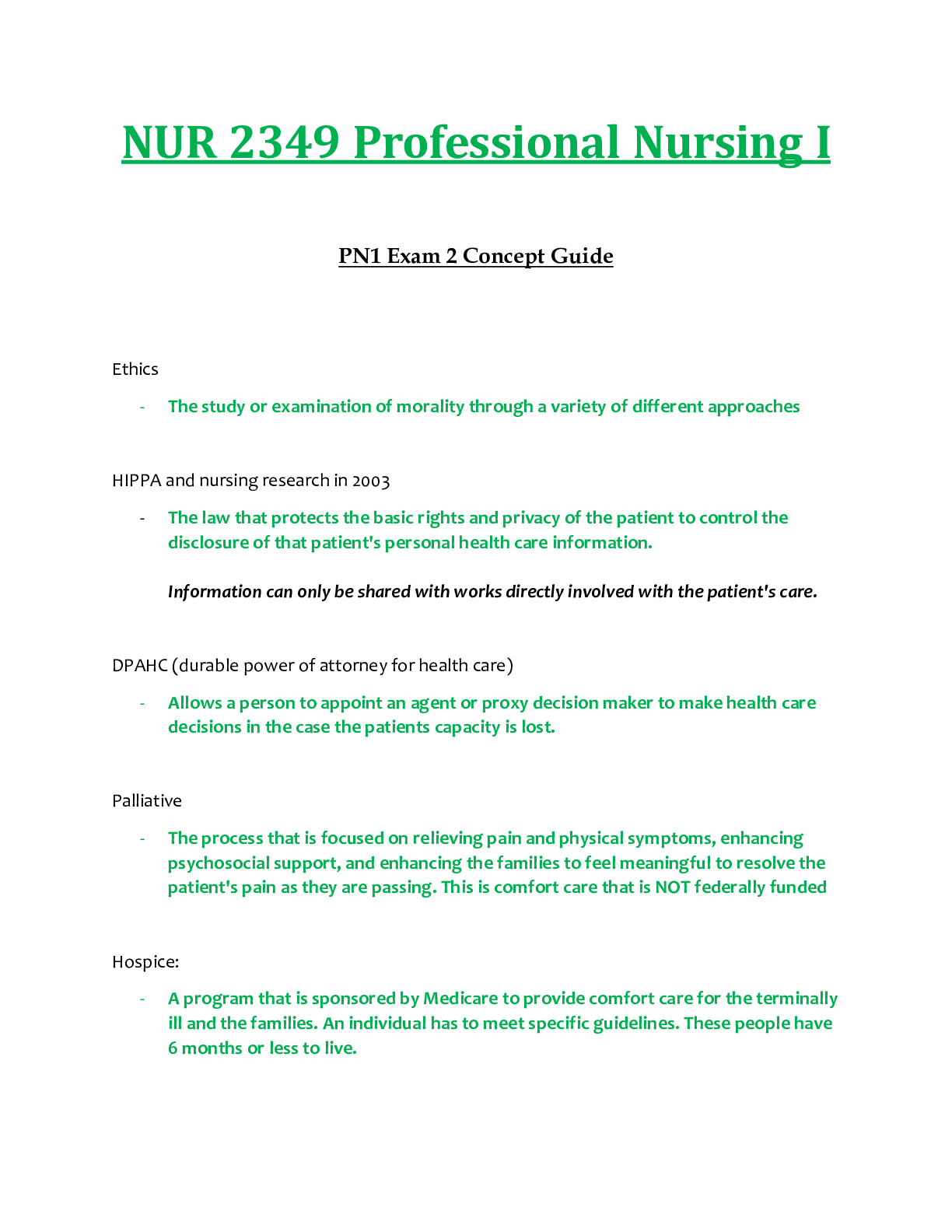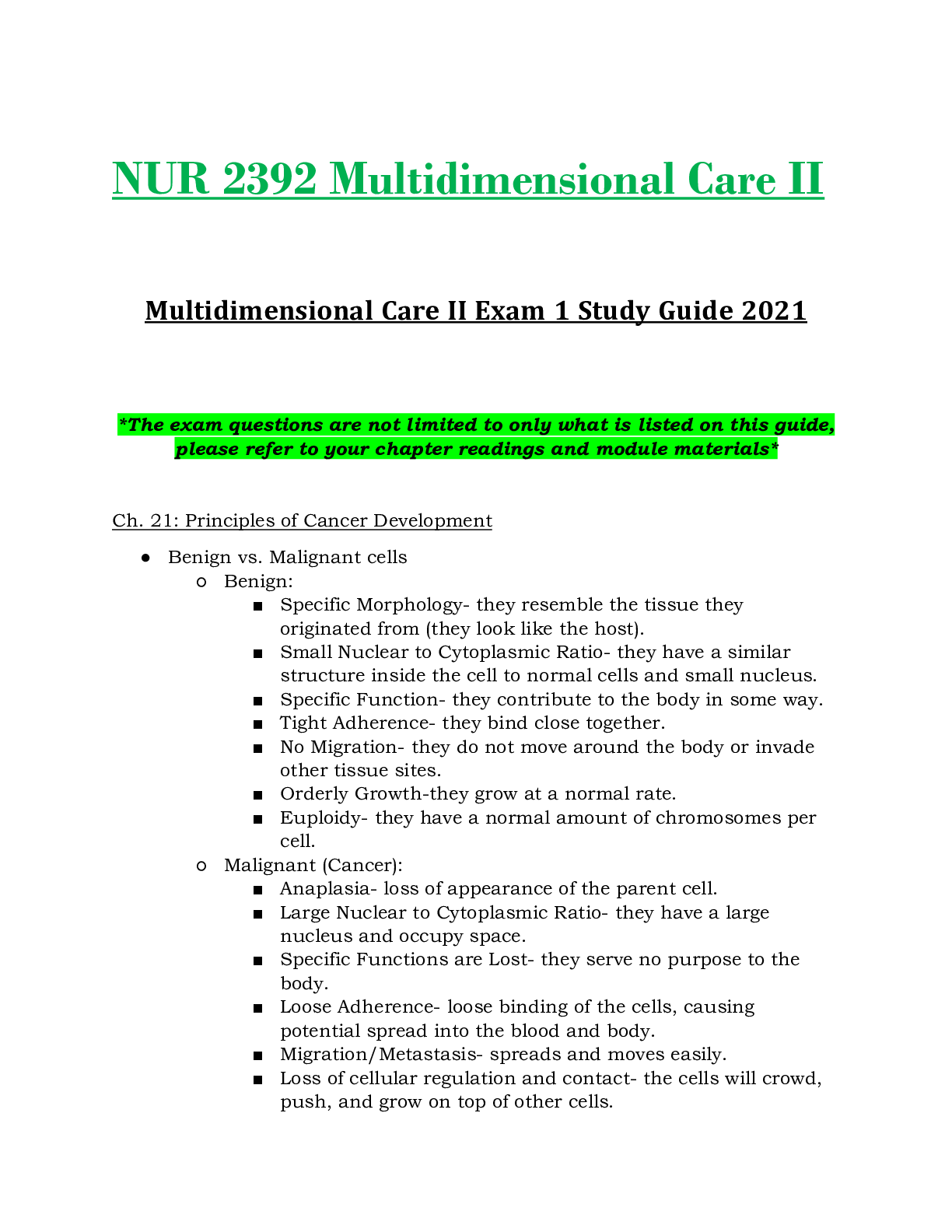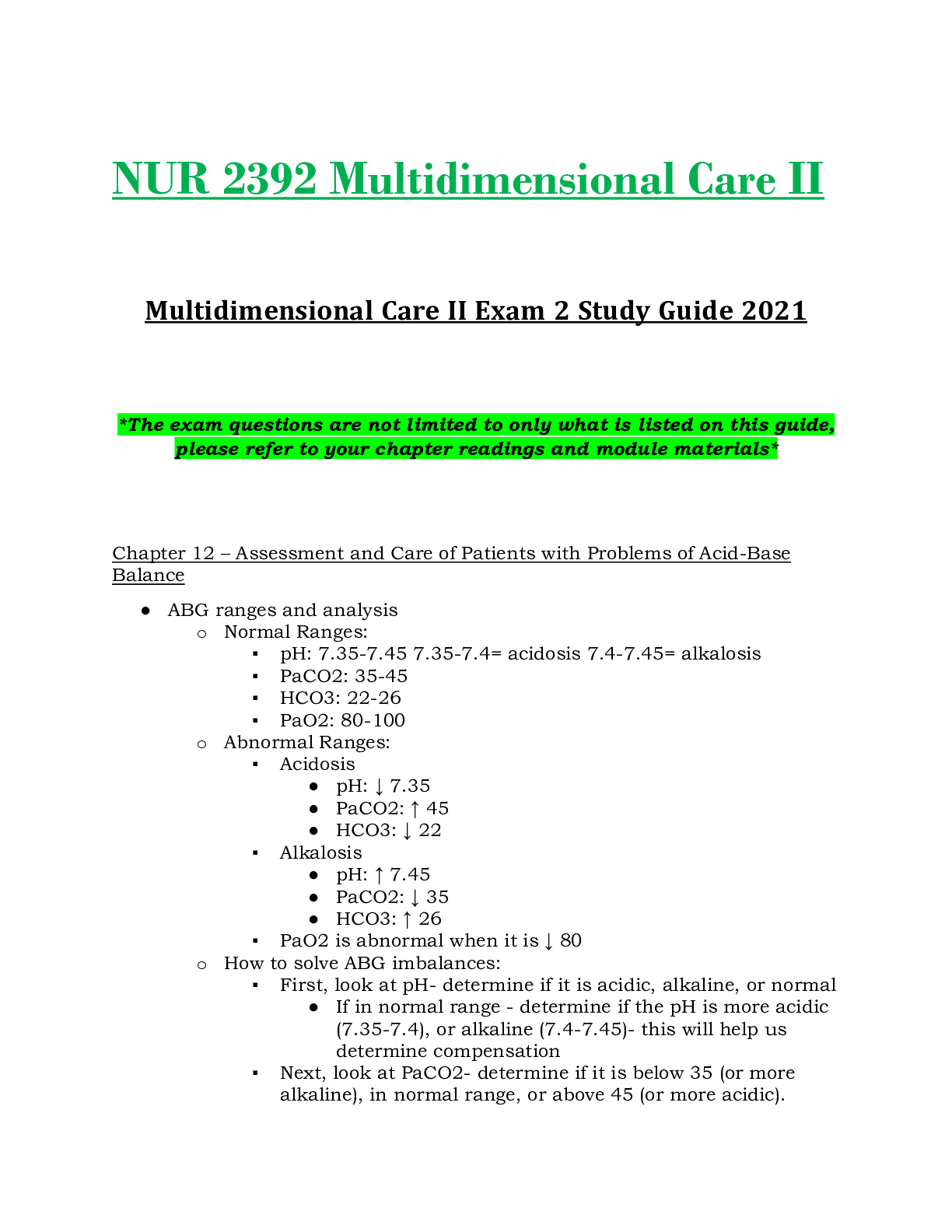*NURSING > STUDY GUIDE > NR 222 Final Exam Study Guide / NR222 Final Exam Study Guide (2020): Health and Wellness: Chamberlai (All)
NR 222 Final Exam Study Guide / NR222 Final Exam Study Guide (2020): Health and Wellness: Chamberlain University (Already graded A)
Document Content and Description Below
NR-222 Health & Wellness Final Exam Study Guide 1. An 18-year-old woman is in the emergency department with fever and cough. The nurse obtains her vital signs, auscultates her lung sounds, liste... ns to her heart sounds, determines her level of comfort, and collects blood and sputum samples for analysis. Which standard of practice is performed? A. Diagnosis B. Evaluation C. Assessment D. Implementation RATIONALE: 2. Advanced practice registered nurses generally: A. Function independently B. Function as unit directors C. Work in acute care settings D. Work in the university setting RATIONALE: 3. As an art nursing relies on knowledge gained from practice and reflection on past experiences. As a science nursing relies on (select all that apply): A. Experimental research. B. Nonexperimental research. C. Research from other disciplines. D. Professional opinions. RATIONALE: 4. Based on the transtheoretical model of change, what is the most appropriate response to a patient who states: "Me, exercise? I haven't done that since junior high gym class, and I hated it then!" A. "That's fine. Exercise is bad for you anyway." B. "OK. I want you to walk 3 miles 4 times a week, and I'll see you in 1 month." C. "I understand. Can you think of one reason why being more active would be helpful for you?" D. "I'd like you to ride your bike 3 times this week and eat at least four fruits and vegetables every day." RATIONALE: 5. The client who would be least likely to participate in health teaching activities would choose which model? A. Clinical model B. Adaptive model C. Role performance model D. Eudemonistic model RATIONALE: T 6. Contemporary nursing requires that the nurse has knowledge and skills for a variety of professional roles and responsibilities. Which of the following are examples? (Select all that apply.) A. Caregiver B. Autonomy and accountability C. Patient advocate D. Health promotion E. Lobbyist RATIONALE: 7. A critical care nurse is using a computerized decision support system to correctly position her ventilated patients to reduce pneumonia caused by accumulated respiratory secretions. This is an example of which Quality and Safety in the Education of Nurses (QSEN) competency? A. Patient-centered care B. Safety C. Teamwork and collaboration D. Informatics RATIONALE: 8. Evidence-based practice is defined as: A. Nursing care based on tradition B. Scholarly inquiry of nursing and biomedical research literature C. A problem-solving approach that integrates best current evidence with clinical practice D. Quality nursing care provided in an efficient and economically sound manner RATIONALE: 9. The examination for registered nurse licensure is exactly the same in every state in the United States. This examination: A. Guarantees safe nursing care for all patients B. Ensures standard nursing care for all patients C. Ensures that honest and ethical care is provided D. Provides a minimal standard of knowledge for a registered nurse in practice RATIONALE: 10. Four distinct models have been used to describe concepts of health. Which of the following statements accurately describes some of the models used? (select all that apply) A. In the clinical health model, health and illness are defined by signs and symptoms of disease. B. The role performance model of health defines health in terms of individuals' ability to perform social roles. C. The clinical model is the basis for occupational health evaluations. D. In the adaptive model of health, people's ability to adjust positively to social, mental, and physiological change is the measure of their health. E. In the eudemonistic model, exuberant well-being indicates optimal health. RATIONALE: 11. Health care reform will bring changes in the emphasis of care. Which of the following models is expected from health care reform? A. Moving from an acute illness to a health promotion, illness prevention model B. Moving from illness prevention to a health promotion model C. Moving from an acute illness to a disease management model D. Moving from a chronic care to an illness prevention model RATIONALE: 12. Health is considered to be a metaparadigm for nursing and includes which of the following components? (select all that apply) A. Person B. Health C. Environment D. Nursing E. Psychosocial wellness RATIONALE: 13. The nurses on an acute care medical floor notice an increase in pressure ulcer formation in their patients. A nurse consultant decides to compare two types of treatment. The first is the procedure currently used to assess for pressure ulcer risk. The second uses a new assessment instrument to identify at-risk patients. Given this information, the nurse consultant exemplifies which career? A. Clinical nurse specialist B. Nurse administrator C. Nurse educator D. Nurse researcher RATIONALE: 14. In addition to changes in ethnic and racial distribution within the population, it is expected that changes in _______ distribution will affect health promotion practice. A. geographic B. environmental C. age D. social RATIONALE: 15. In assessing the nutritional-metabolic pattern, the nurse performs an examination of: A. attention span. B. blood pressure. C. mucous membranes. D. urine color. RATIONALE: 16. The individual's perceived health and well-being and how health is managed describes the: A. cognitive-perceptual pattern. B. coping-stress tolerance pattern. C. health perception-health management pattern. D. self-perception-self-concept pattern. RATIONALE: 17. Major goals in assessing each person's functional pattern are to determine: (select all that apply) A. ability to manage health-promoting activities. B. herbal medications that promote health. C. knowledge of health promotion. D. the need for physician referral for illness care. E. the value that the person ascribes to health promotion. RATIONALE: 18. A male patient has been laid off from his construction job and has many unpaid bills. He is going through a divorce from his marriage of 15 years and has been seeing his pastor to help him through this difficult time. He does not have a primary health care provider because he has never really been sick and his parents never took him to the physician when he was a child. Which external variables influence the patient's health practices? (Select all that apply.) A. Difficulty paying his bills B. Seeing his pastor as a means of support C. Family practice of not routinely seeing a health care provider D. Stress from the divorce and the loss of a job RATIONALE: 19. Match the following components of systems theory with the definition of that component. A. Feedback B. Input C. Content D. Output 1. Data entering the system 2. End product 3. Data related to system functioning 4. Product and information obtained from the system A. Feedback-- B. Input----- C. Content----- D. Output---- 20. Match the following theories with their definitions. A. Grand theory B. Middle-range theory C. Descriptive theory D. Prescriptive theory 1. Addresses specific phenomena and reflect practice 2. First level in theory development and describes a phenomenon 3. Provides a structural framework for broad concepts about nursing 4. Linked to outcomes (consequences of specific nursing interventions) A. Grand theory---- B. Middle-range theory---- C. Descriptive theory---- D. Prescriptive theory---- 21. The nurse assesses a community for evidence of health-promotion strategies. Which of the following are health-promotion strategies? (select all that apply) A. Seeking primary care in the acute care hospital B. Self-care for minor illness C. Entry into acute care facilities to manage chronic illness D. Environmental changes to enhance clean air E. Supporting Habitat for Humanity house construction RATIONALE: 22. The nurse assesses the following risk factors for coronary artery disease (CAD) in a male patient. Which factors are classified as genetic and physiological? (Select all that apply.) A. Sedentary lifestyle B. Father died from CAD at age 50 C. History of hypertension D. Eats diet high in sodium E. Elevated cholesterol level F. Age is 44 years RATIONALE: 23. A nurse is applying Henderson's theory as a basis for theory based-nursing practice. Which other elements are important for theory-based nursing practice? (Select all that apply.) A. Knowledge of nursing science B. Knowledge of related sciences C. Knowledge about current health care issues D. Knowledge of standards of practice RATIONALE: 24. A nurse is caring for an older-adult couple in a community-based assisted living facility. During the family assessment he notes that the couple has many expired medications and multiple medications for their respective chronic illnesses. They note that they go to two different health care providers. The nurse begins to work with the couple to determine what they know about their medications and helps them decide on one care provider rather than two. This is an example of which Quality and Safety in the Education of Nurses (QSEN) competency? A. Patient-centered care B. Safety C. Teamwork and collaboration D. Informatics RATIONALE: 25. A nurse is caring for a patient with end-stage lung disease. The patient wants to go home on oxygen and be comfortable. The family wants the patient to have a new surgical procedure. The nurse explains the risk and benefits of the surgery to the family and discusses the patient's wishes with the family. The nurse is acting as the patient's: A. Educator B. Advocate C. Caregiver D. Case manager RATIONALE: 26. The nurse is conducting a home visit with an older adult couple. She assesses that the lighting in the home is poor and there are throw rugs throughout the home and a low footstool in the living room. She discusses removing the rugs and footstool and improving the lighting with the couple. The nurse is addressing which level of need according to Maslow? A. Physiological B. Safety and security C. Love and belonging D. Self-actualization RATIONALE: 27. The nurse is developing a health promotion program on healthy eating and exercise for high school students using the health belief model as a framework. Which statement made by a nursing student is related to the individual's perception of susceptibility to an illness? A. "I don't have time to exercise because I have to work after school every night." B. "I'm worried about becoming overweight and getting diabetes because my father has diabetes." C. "The statistics of how many teenagers are overweight is scary." D. "I've decided to start a walking club at school for interested students." RATIONALE: 28. A nurse is going to teach a patient how to perform breast self-examination. Which behavioral objective does the nurse set to best measure the patient's ability to perform the examination? A. The patient will verbalize the steps involved in breast self-examination within 1 week. B. The nurse will explain the importance of performing breast self-examination once a month. C. The patient will perform breast self-examination correctly on herself before the end of the teaching session. D. The nurse will demonstrate breast self-examination on a breast model provided by the American Cancer Society. RATIONALE: 29. The nurse is participating at a health fair at the local mall giving influenza vaccines to senior citizens. What level of prevention is the nurse practicing? A. Primary prevention B. Secondary prevention C. Tertiary prevention D. Quaternary prevention RATIONALE: 30. The nurse is performing an initial antepartal assessment on a woman who has missed two periods. Assessment of this woman for alcohol consumption is best determined by the: A. CAGE test. B. T-ACE test. C. non-stress test. D. protein dipstick test. RATIONALE: 31. A nurse is planning a teaching session about healthy nutrition with a group of children who are in first grade. The nurse determines that after the teaching session the children will be able to name three examples of foods that are fruits. This is an example of: A. A teaching plan. B. A learning objective. C. Reinforcement of content. D. Enhancing the children's self-efficacy. RATIONALE: 32. The nurse is planning to teach a patient about the importance of exercise. When is the best time for teaching to occur? (Select all that apply.) A. When there are visitors in the room B. When the patient's pain medications are working C. Just before lunch, when the patient is most awake and alert D. When the patient is talking about current stressors in his or her life RATIONALE: 33. The nurse is preparing a class on wellness and health promotion for a group of middle school students. Developmental tasks of early adolescence include a learning focus emphasis on: A. coping with life events and problems. B. economic responsibility. C. risk taking and its consequences. D. social responsibility for self and others. RATIONALE: 34. The nurse is preparing education on prevention of urinary tract infections. A principle emphasized in the teaching plan would be: A. Decreasing oral intake facilitates urinary dilution. B. Empty the bladder at the first sensation of fullness. C. Frequency is a common symptom that can be ignored. D. Increasing time between urinations decreases the risk of infection. RATIONALE: 35. A nurse is teaching a 27-year-old gentleman how to adjust his insulin dosages based on his blood sugar results. What type of learning is this? A. Cognitive B. Affective C. Adaptation D. Psychomotor RATIONALE: 36. The nurse is teaching about primary prevention and includes which educational statement in the instructions? A. Everyone should participate in colorectal cancer screening. B. Health teaching about the risk factors of heart disease should be performed. C. Limiting disability is a vital role of nursing since preventive measures are therapeutic. D. The nurse is involved in minimizing the effects of disease and disability by surveillance and maintenance. RATIONALE: 37. A nurse is teaching a group of young college-age women the importance of using sunscreen when going out in the sun. What type of content is the nurse providing? A. Simulation B. Restoring health C. Coping with impaired function D. Health promotion and illness prevention RATIONALE: 38. The nurse is teaching a parenting class to a group of pregnant adolescents. The nurse pretends to be the baby's father, and the adolescent mother is asked to show how she would respond to the father if he gave her a can of beer. Which teaching approach did the nurse use? A. Role play B. Discovery C. An analogy D. A demonstration RATIONALE: 39. A nurse needs to teach a young woman newly diagnosed with asthma how to manage her disease. Which of the following topics does the nurse teach first? A. How to use an inhaler during an asthma attack B. The need to avoid people who smoke to prevent asthma attacks C. Where to purchase a medical alert bracelet that says she has asthma D. The importance of maintaining a healthy diet and exercising regularly RATIONALE: 40. Nurses at a community hospital are in an education program to learn how to use a new pressure-relieving device for patients at risk for pressure ulcers. This is which type of education? A. Continuing education B. Graduate education C. In-service education D. Professional Registered Nurse Education RATIONALE: 41. Nurses in the school setting can participate in health promotion activities through creating nut-free schools. This would protect hypersensitive children from life-threatening allergic reactions to peanuts and other nut products. This type of program is an example of which of the following interventions? A. Primary B. Secondary C. Tertiary D. Emergent RATIONALE: 42. The nurse, teaching a class on primary prevention at a women's health club, emphasizes participation in: A. physician visits during illness. B. recommended immunization schedules. C. taking antibiotics at the first sign of symptoms. D. water aerobics to develop muscle building. RATIONALE: 43. A nurse works in a special care unit for children with severe immunology problems and is caring for a 3-year-old boy from Greece. The boy's father is with him while his mother and sister are back in Greece. The nurse is having difficulty communicating with the father. What action does the nurse take? A. Care for the boy as she would any other patient B. Ask the manager to talk with the father and keep him out of the unit C. Have another nurse care for the boy because maybe that nurse will do better with the father D. Search for help with interpretation and understanding of the cultural differences by contacting someone from the local Greek community RATIONALE: 44. An older adult is being started on a new antihypertensive medication. In teaching the patient about the medication, the nurse: A. Speaks loudly. B. Presents the information once. C. Expects the patient to understand the information quickly. D. Allows the patient time to express himself or herself and ask questions. RATIONALE: 45. A patient at the community clinic asks the nurse about health promotion activities that she can do because she is concerned about getting diabetes mellitus since her grandfather and father both have the disease. This statement reflects that the patient is in what stage of the health belief model? A. Perceived threat of the disease B. Likelihood of taking preventive health action C. Analysis of perceived benefits of preventive action D. Perceived susceptibility to the disease. RATIONALE: 46. A patient comes to the local health clinic and states: "I've noticed how many people are out walking in my neighborhood. Is walking good for you?" What is the best response to help the patient through the stages of change for exercise? A. "Walking is OK. I really think running is better." B. "Yes, walking is great exercise. Do you think you could go for a 5-minute walk next week?" C. "Yes, I want you to begin walking. Walk for 30 minutes every day and start to eat more fruits and vegetables." D. "They probably aren't walking fast enough or far enough. You need to spend at least 45 minutes if you are going to do any good." RATIONALE: 47. A patient experienced a myocardial infarction 4 weeks ago and is currently participating in the daily cardiac rehabilitation sessions at the local fitness center. In what level of prevention is the patient participating? A. Primary prevention B. Secondary prevention C. Tertiary prevention D. Quaternary prevention RATIONALE: 48. A patient in the emergency department has developed wheezing and shortness of breath. The nurse gives the ordered medicated nebulizer treatment now and in 4 hours. Which standard of practice is performed? A. Planning B. Evaluation C. Assessment D. Implementation RATIONALE: 49. A patient is admitted to an acute care area. The patient is an active business man who is worried about getting back to work. He has had severe diarrhea and vomiting for the last week. He is weak, and his breathing is labored. Using Maslow's hierarchy of needs, identify this patient's immediate priority. A. Self-actualization B. Air, water, and nutrition C. Safety D. Esteem and self-esteem needs RATIONALE: 50. A patient needs to learn how to administer a subcutaneous injection. Which of the following reflects that the patient is ready to learn? A. Describing difficulties a family member has had in taking insulin B. Expressing the importance of learning the skill correctly C. Being able to see and understand the markings on the syringe D. Having the dexterity needed to prepare and inject the medication RATIONALE: 51. A patient needs to learn to use a walker. Which domain is required for learning this skill? A. Affective domain B. Cognitive domain C. Attentional domain D. Psychomotor domain RATIONALE: 52. A patient newly diagnosed with cervical cancer is going home. The patient is avoiding discussion of her illness and postoperative orders. What is the nurse's best plan in teaching this patient? A. Teach the patient's spouse B. Focus on knowledge the patient will need in a few weeks C. Provide only the information that the patient needs to go home D. Convince the patient that learning about her health is necessary RATIONALE: 53. The patient states she joined a fitness club and attends the aerobics class three nights a week. The patient is in what stage of behavioral change? A. Precontemplation B. Contemplation C. Preparation D. Action RATIONALE: 54. A patient who is hospitalized has just been diagnosed with diabetes. He is going to need to learn how to give himself injections. Which teaching method does the nurse use? A. Simulation B. Demonstration C. Group instruction D. One-on-one discussion RATIONALE: 55. A patient with a 20-year history of diabetes mellitus had a lower leg amputation. Which statement made by the patient indicates that he is experiencing a problem with body image? A. "I just don't have any energy to get out of bed in the morning." B. "I've been attending church regularly with my wife since I got out of the hospital." C. " My wife has taken over paying the bills since I've been in the hospital." D. "I don't go out very much because everyone stares at me." RATIONALE: 56. A patient with chest pain is having an emergency cardiac catheterization. Which teaching approach does the nurse use in this situation? A. Telling approach B. Selling approach C. Entrusting approach D. Participating approach RATIONALE: 57. A patient with diabetes is controlling the disease with insulin and diet. The nursing health care provider is focusing efforts to teach the patient self-management. Which of the following nursing theories is useful in promoting self-management? A. Neuman B. Orem C. Roy D. Peplau RATIONALE: 58. A person reports his exercise pattern is one golf game per week. The nurse evaluates this pattern and teaches the individual that: A. exercise should include jogging. B. exercises should be repetitive. C. golfing one time per week is adequate. D. weekly workouts at the gym should be included. RATIONALE: 59. Public health nurses are involved in supporting active health promotion strategies such as: A. supporting clean water. B. advocating for vitamin D in all milk. C. supporting sanitary sewage systems. D. participating in an individual daily exercise program. RATIONALE: 60. The school nurse is about to teach a freshman-level high school health class about nutrition. What is the best instructional approach to ensure that the students meet the learning outcomes? A. Provide information using a lecture B. Use simple words to promote understanding C. Develop topics for discussion that require problem solving D. Complete an extensive literature search focusing on eating disorders RATIONALE: 61. Theory-based nursing practice uses a theoretical approach for nursing care. This approach moves nursing forward as a science. This suggests that: A. One theory will guide nursing practice. B. Scientists will decide nursing decisions. C. Nursing will only base patient care on the practice of other sciences. D. Theories will be tested to describe or predict patient outcomes RATIONALE: 62. A theory is a set of concepts, definitions, relationships, and assumptions that: A. Formulate legislation. B. Explain a phenomenon. C. Measure nursing functions. D. Reflect the domain of nursing practice. RATIONALE: 63. To practice in today's health care environment, nurses need a strong scientific knowledge base from nursing and other disciplines such as the physical, social, and behavioral sciences. This statement identifies the need for which of the following? A. Systems theories B. Developmental theories C. Interdisciplinary theories D. Health and wellness models RATIONALE: 64. What are the two overarching goals of Healthy People 2010? (select two that apply) A. Increase quality and years of life B. Eliminate health disparities C. Create access to preventive services for all. D. Increase the span of healthy life RATIONALE: 65. When a nurse is teaching a patient about how to administer an epinephrine injection in case of a severe allergic reaction, he or she tells the patient to hold the injection like a dart. Which of the following instructional methods did the nurse use? A. Telling B. Analogy C. Demonstration D. Simulation RATIONALE: 66. When assessing the older adult for sleep quality, the nurse expects to find that the person will state: A. "I continue to be a night owl." B. "I experience difficulty returning to sleep." C. "I experience a night of deep sleep." D. "I rarely wake up during the night." RATIONALE: 67. When illness occurs, different attitudes about it cause people to react in different ways. What do medical sociologists call this reaction to illness? A. Health belief B. Illness behavior C. Health promotion D. Illness prevention RATIONALE: 68. When taking care of patients, the nurse routinely asks them if they take any vitamins or herbal medications, encourages family members to bring in music that the patient likes to help the patient relax, and frequently prays with her patients if that is important to them. The nurse is practicing which model? A. Holistic B. Health belief C. Transtheoretical D. Health promotion 69. When teaching about proper nutrition to a person with congestive heart failure, which affective component should be included in the educational plan? A. Eating with someone B. Food preparation techniques C. Knowledge of dietary restrictions D. Values of adhering to the diet RATIONALE: 70. Which activity represents secondary prevention? A. A home health care nurse visits a patient's home to change a wound dressing. B. A 50-year-old woman with no history of disease attends the local health fair and has her blood pressure checked. C. The school health nurse provides a program to the first-year students on healthy eating. D. The patient attends cardiac rehabilitation sessions weekly. RATIONALE: 71. Which of the following agencies or initiatives have been driving forces in health care reform and the prevention of disease in society? (select all that apply) A. Healthy People B. Health Insurance Portability and Accountability Act C. U.S. Department of Health, Education, and Welfare D. Patient Protection and Affordable Care Act E. U.S. Department of Health and Human Services RATIONALE: 72. Which of the following are components of the paradigm of nursing? A. The person, health, environment, and theory B. Health, theory, concepts, and environment C. Nurses, physicians, health, and patient needs D. The person, health, environment/situation, and nursing RATIONALE: 73. Which of the following is closely aligned with Leininger's theory? A. Caring for patients from unique cultures B. Understanding the humanistic aspects of life C. Variables affecting a patient's response to a stressor D. Caring for patients who cannot adapt to internal and external environmental demands RATIONALE: 74. Which of the following nursing roles may have prescriptive authority in their practice? (Select all that apply.) A. Critical care nurse B. Nurse practitioner C. Certified clinical nurse specialist D. Charge nurse RATIONALE: 75. Which of the following statements about theory-based nursing practice is incorrect? A. Contributes to evidence-based practice B. Provides a systematic process for designing nursing interventions C. Is not linked to nursing outcomes D. Guides the nurse's assessment RATIONALE: 76. Which of the following statements apply to theory generation? (Select all that apply.) A. Builds scientific knowledge base of nursing B. Discovers relationships of phenomena to practice C. Tests specific phenomena D. Identifies observations about a phenomenon RATIONALE: 77. Which of the following theories describe the life processes of an older adult facing chronic illness? A. Systems theories B. Developmental theories C. Interdisciplinary theories D. Health and wellness models RATIONALE: 78. While working in a community health clinic, it is important to obtain nursing histories and get to know the patients. Part of history taking is to develop the nurse-patient relationship. Which of the following apply to Peplau's theory when establishing the nurse-patient relationship? (Select all that apply.) A. An interaction between the nurse and patient must develop. B. The patient's needs must be clarified and described. C. The nurse-patient relationship is influenced by patient and nurse preconceptions. D. The nurse-patient relationship is influenced only by the nurse's preconceptions. RATIONALE: 79. You are participating in a clinical care coordination conference for a patient with terminal cancer. You talk with your colleagues about using the nursing code of ethics for professional registered nurses to guide care decisions. A non-nursing colleague asks about this code. Which of the following statements best describes this code? A. Improves self-health care B. Protects the patient's confidentiality C. Ensures identical care to all patients D. Defines the principles of right and wrong to provide patient care RATIONALE: [Show More]
Last updated: 2 years ago
Preview 1 out of 15 pages

Buy this document to get the full access instantly
Instant Download Access after purchase
Buy NowInstant download
We Accept:

Reviews( 1 )

by Bchaplynski · 4 years ago
$11.00
Can't find what you want? Try our AI powered Search
Document information
Connected school, study & course
About the document
Uploaded On
Nov 15, 2020
Number of pages
15
Written in
Additional information
This document has been written for:
Uploaded
Nov 15, 2020
Downloads
2
Views
159

